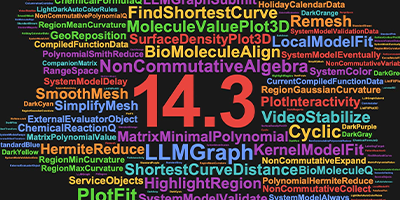Microsoft, Wolfram and the Future of Computable Data

With the recent addition of Wolfram|Alpha knowledge to Microsoft Office 365, Wolfram has now delivered computational knowledge integration projects to four of the five biggest tech companies in the world. Products central to the business of these big companies, such as Apple’s Siri and now Microsoft Excel, rely on Wolfram to deliver knowledge and computation, on demand and at scale.
Why do these top organizations come to Wolfram?
The answer has two parts.
1. Wolfram Does Computable Data
Data is cheap, and there is no end to suppliers of data on every topic. But data alone isn’t enough. For data to be actionable—so that you can find meaningful insights and make better, informed decisions—it must be set up in a way that is immediately usable in a wide range of computations. Wolfram is the only company to make that a practical reality consistently across multiple domains.
Think of the places where you get information and consider the level that they reach on Wolfram’s computable data scale. You’ll quickly see that they typically fall far short of level 10: data suitable for repeated, systematic computations.

But does this careful design and curation matter? “Search” as an approach ignores this completely, and the data you get is typically level 1 or 2, but that is why there is very little computational insight across web-sourced data, and what little there is requires immense human effort. There are plenty of specialized data sources where computation can be done within a narrow domain, but that is because a developer has worked out the reports and computations for specific queries.
Even the simplest computation, such as adding two data points, is dangerous with raw data unless you bring a human developer in to answer key questions. Are numbers in the same units? Are they categorized and labeled the same way? If they are dates, are they in the same date system/time zone/time granularity? If the data is comprised of images, sound or videos, are they the same sample rates, number of channels and colorspace? What if they are time series but of different lengths or different sample rates?
This is important for the “question-and-answer” integration that Wolfram provides for digital assistants, but it is vital for live data to be reusable within Excel.
Computable data works.
2. Wolfram Is Serious
Having unique technology isn’t enough. Plenty of startups have smart ideas. But when a $292 billion company like Microsoft wants to use technology to add power to one of its most important products, reliability is paramount—not only reliable technology but also, more importantly, a reliable organization. With over 30 years of experience, Wolfram hasn’t just built great technology: it’s built processes, a team and a culture.
Because other companies know that Wolfram runs very high-traffic websites plus the existing API feeds to Apple’s Siri and others without major incident; that we have technical service teams around the world solving data science problems and building custom solutions for companies across many industries; and even that we have maintained steady business practices with our customers over the long term, they know that we’re the right company to work with. Smart, yes, but smart with a solid reputation too.
The Wolfram Language is the power behind global computation, from consumer access via the world’s major intelligent assistants to millions of daily queries being answered directly through Wolfram|Alpha to expert computable use within Mathematica through licenses purchased by the world’s major commercial research labs and universities (and sometimes even entire countries). With the Microsoft 365 Excel integration, another ecosystem of 750 million users will make computable use of the Wolfram Knowledgebase.
Wolfram is how the world computes with knowledge.



Comments